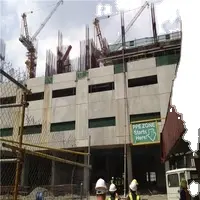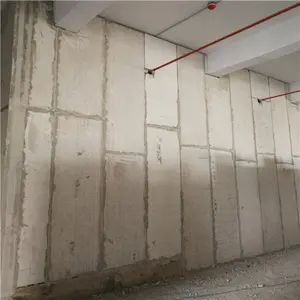(1724 products available)



























































































































































































































Lightweight concrete cladding panels are precast construction materials made from light aggregate concrete. They are designed for exterior wall cladding applications in residential, commercial, and industrial construction projects.
These panels are lightweight, making them easy to handle and transport. They also have inherent strength and durability of concrete, providing a long-lasting and low-maintenance solution for cladding. Their ease of customization permits a wide range of finishes, textures, and colors to meet specific design requirements.
Lightweight concrete cladding panels are available in different types as discussed below:
Fiber Reinforced Concrete (FRC) Panels
Fiber Reinforced Concrete (FRC) panels are lightweight concrete cladding panels that incorporate fibrous materials. These fibers are added to the concrete mix to enhance structural integrity and durability. The common fibers used include synthetic, polypropylene, steel, and glass fibers.
These cladding panels are characterized by their improved crack resistance, reduced permeability, and enhanced tensile strength. They are suitable for various applications, such as architectural walls, commercial buildings, residential garages, and residential homes. Additionally, they come in different sizes and finishes, such as smooth, textured, and architectural.
Precast Lightweight Insulated Concrete Panels
These panels consist of a concrete layer with insulation and lightweight aggregates. They are designed to provide structural integrity, insulation, and a finished exterior face in one single product.
Insulated concrete panels are characterized by their high insulation value, lightweight nature, and structural strength. They are ideal for use in climates where energy efficiency is a priority. Additionally, their installation is cost-effective, resulting in a reduced overall project time. They are suitable for commercial buildings, residential construction, healthcare facilities, and educational institutions.
Thin Concrete Overlay Panels
These panels are developed by applying a thin concrete overlay to a lightweight aggregate base. They are designed to mimic the appearance of traditional concrete surfaces while offering lightweight and easy-to-install properties.
Thin concrete overlay panels are characterized by their decorative versatility, lightweight nature, and ease of installation. They provide a cost-effective solution for aesthetic enhancements. These panels are suitable for applications such as façade renovations, decorative walls, accent features, and interior walls.
Lightweight concrete cladding panels are versatile and innovative construction components with several functions and features. These include:
Durability and Longevity
Lightweight concrete cladding panels offer exceptional durability and longevity. These panels are made from concrete, which is inherently strong and resistant to various damages. This includes rot, pests, and rust. Additionally, concrete does not require frequent replacements or extensive repairs. As such, this ensures that structures maintain their aesthetic appeal and functionality for many years. The long-lasting nature of these cladding panels reduces the need for replacement. This in turn minimizes waste and promotes environmental sustainability. Their durability makes them a preferred choice for environmentally-conscious builders.
Lightweight and Easy Handling
These cladding panels are designed to be lightweight, with the inclusion of materials such as expanded polystyrene (EPS) or lightweight aggregates. The lightweight nature of these panels allows for easier handling during transportation and installation. This not only reduces labor costs but also minimizes the risk of injuries associated with handling heavy materials. Additionally, the lightweight concrete cladding panels can be installed quickly and efficiently. This reduces the overall construction time and enhances project timelines.
Aesthetic Versatility
These panels have diverse applications, which enhance their aesthetic appeal. They come in different finishes, textures and colors to enhance the visual appeal of any building. These include wood, stone finishes, smooth or textured surfaces. This allows for seamless integration with different architectural styles and design preferences. The cladding panels can mimic traditional materials such as wood and stone. This provides a modern and sleek look to any structure.
Thermal Insulation
Thermal insulation is the ability of a material to resist the flow of heat. This helps in maintaining a stable indoor temperature. Lightweight concrete cladding panels have closed-cell foam insulation in their composition. This creates an effective thermal barrier. This reduces the need for heating and cooling systems. As such, this leads to significant energy savings and lower utility bills. Additionally, this insulation property enhances the overall energy efficiency of a building and promotes environmentally-responsible building practices.
Fire Resistance
These cladding panels are made from concrete, which is non-combustible. This means that it does not burn or support the spread of fires. The fire resistance of lightweight concrete cladding panels enhances the safety of buildings and protects occupants and property. Additionally, their fire resistance allows for compliance with local building codes and regulations. This is especially for those requiring fire-rated materials in residential and commercial construction.
Lightweight concrete cladding panels offer a range of applications due to their unique combination of strength, durability, and lightweight properties. Here are some common usage scenarios:
Architectural Facades
These panels are used to create stunning architectural facades in commercial and residential buildings. Their finishes replicate, ranging from sleek modern designs to traditional textures. Their lightweight nature allows for easy installation, reducing construction time and labor costs.
Interior Wall Cladding
Lightweight concrete cladding panels provide interior wall cladding solutions. When used indoors, they add an aesthetic appeal and improve fire resistance and impact durability. These panels create visually appealing accent walls in lobbies, living rooms, and entertainment spaces.
Exterior Wall Cladding
These panels are used for exterior wall cladding in both residential and commercial buildings. They enhance the building's appearance and provide a durable and low-maintenance exterior surface. These panels also offer insulation properties, improving the energy efficiency of the building.
Retaining Walls
Retaining walls made of lightweight concrete cladding panels offer a combination of strength and stability with an aesthetic finish. They can withstand soil pressure while maintaining a visually appealing look.
Skincare Clinics and Hospitals
These panels provide a hygienic and easy-to-clean surface, improving the facility's overall appearance. Their antimicrobial properties help prevent the spread of germs and bacteria.
Pool Areas
Lightweight concrete cladding panels are ideal for areas around pools. They are water-resistant, non-slip, and easy to clean, making them safe and practical for use in pool areas.
Vertical Gardens
Vertical gardens are structures that support plant growth on walls. Lightweight concrete cladding panels can be used in vertical gardens by providing a stable surface for plant growth and irrigation systems.
Parking Garages
These panels are used in parking garages due to their durability and resistance to moisture. They can withstand vehicle impact and exposure to water and chemicals, ensuring a long-lasting and low-maintenance surface.
Sound Barriers
Sound barriers are structures built to reduce noise from highways, railways, and other sources. Lightweight concrete cladding panels can effectively create sound barriers by absorbing and deflecting noise.
When choosing lightweight concrete cladding panels, consider the following factors:
Project requirements
Each construction project has unique needs that must be met. These include the desired appearance, structural requirements, and financial constraints. These factors must be considered when choosing lightweight concrete cladding panels to ensure they are appropriate for the intended use and are within budget.
Panel performance
Thanks to their superior durability, thin concrete panels are ideal for use in construction. They can withstand severe weather conditions, including rain, snow, and high winds, without breaking or deteriorating. Additionally, these panels can survive scratches, dents, and cracks, keeping their appearance over time.
Another key feature of lightweight concrete cladding panels is their fire resistance. Thanks to their non-combustible nature, these panels can help slow fire spread and offer vital protection to building occupants and property.
Panel weight
Due to their light weight, thin concrete panels are easy to handle and install, which can save time and labor costs. Their lightweight nature can also reduce the structural load on a building, allowing for more flexible design options and increasing the efficiency of the overall construction process.
Aesthetics
The finish of the concrete cladding panels affects the overall appearance of a structure. Consider concrete panels with a customizable finish, as they allow the incorporation of different textures and colors that complement the building design. Additionally, consider panels with a smooth surface that reflect light and make the building look more spacious. Lightweight concrete cladding panels with a brick or stone texture can also add a classic, timeless appeal to the building.
Cost
As previously discussed, lightweight concrete cladding panels are cost-effective. However, not all of them are budget-friendly. Some options, such as precast panels, may be more expensive than other types. Therefore, it is important to consider the initial cost when selecting cladding panels. This entails evaluating the cost per square meter of different panel options and choosing the one that fits the budget.
Additionally, consider the long-term costs associated with each type of panel. This includes maintenance costs and potential replacement costs. While some cladding panels may have a lower upfront cost, they may require more maintenance over time, which can add up.
Q1. Can someone install lightweight concrete cladding panels by themselves?
A1. Panel installation depends on the expertise required and whether it is a DIY project. Someone can install the panels if it is a small-scale project. However, a professional is required for a large-scale project. Also, concrete cladding panels come with a detailed installation guide that one can follow to install them.
Q2. What does one need to install concrete cladding panels?
A2. If one is installing the panels by themselves, they need basic tools, an installation guide, and safety gear. For large-scale panel installation, professionals and advanced installation tools are required.
Q3. How does one maintain concrete cladding panels?
A3. The cladding panels are easy to maintain. Therefore, they require minimal maintenance. Simply washing it with clean water and detergent is enough.
Q4. Are concrete cladding panels cost-effective?
A4. Yes, it is. Although the initial cost of buying and installing cladding panels is high, long-term costs are low. This is because the panels are durable and require little maintenance.
Q5. Can concrete cladding panels be customized?
A5. Yes, it is. Concrete cladding panels can be customized to fit different sizes, textures, and colors. This allows homeowners to choose panels that complement their home design.